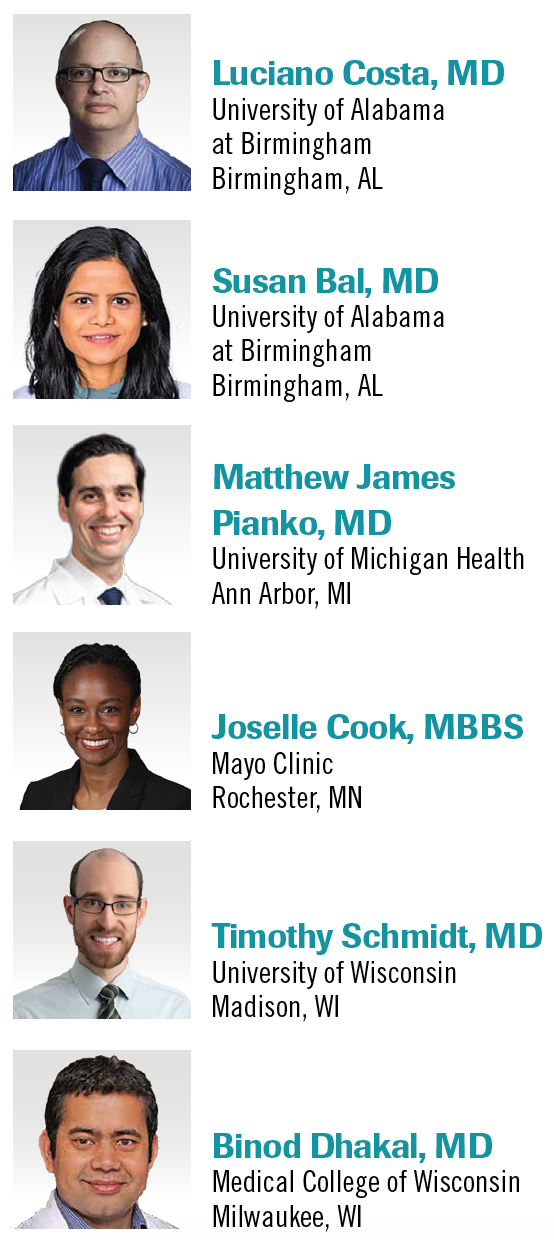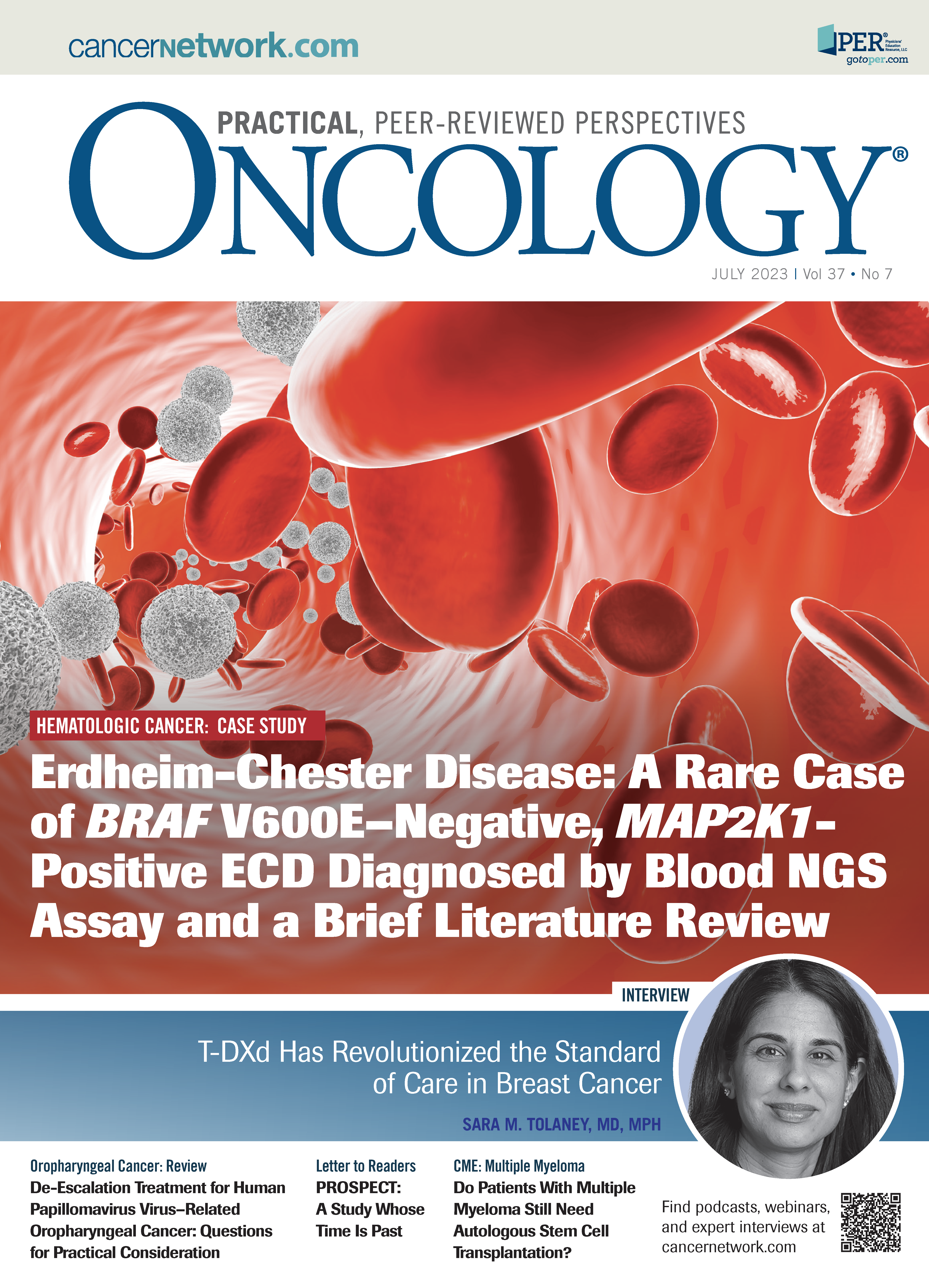Recap: Available Treatment Options in Transplant-Eligible Multiple Myeloma
Experts in the multiple myeloma space discuss recent developments and how to implement new practices in real-world settings.

At the 2023 American Society of Clinical Oncology (ASCO) Annual Meeting, experts in the multiple myeloma space gathered to discuss recent updates and how to implement these new practices in real-world settings. The panel touched on current treatment options for patients who are transplant eligible and have been newly diagnosed with the disease.
The panel was led by Luciano Costa, MD, professor of medicine at the University of Alabama at Birmingham. Other panelists included Susan Bal, MD, assistant professor of medicine at the University of Alabama at Birmingham; Matthew James Pianko, MD, clinical assistant professor at University of Michigan Health; Joselle Cook, MBBS, assistant professor of medicine at the Mayo Clinic; Timothy Schmidt, MD, assistant professor at the University of Wisconsin; and Binod Dhakal, MD, associate professor at the Medical College of Wisconsin.
Options for Determining Transplant Eligibility
The conversation began by discussing how transplant eligibility is determined, and which therapy might be best for this population. Cook noted that to identify patients who are eligible for transplant, she considers chronological and physiologic age, frailty, and comorbidities. She will also consider any patient values that may be expressed when treatment options are discussed.
Pianko approaches transplant eligibility the same way, and typically, when meeting with patients, he presents recent data about how transplant can prolong the duration of time until relapse. Patients who may be eligible for transplant can also be defined as high risk or standard risk, which may determine the type of treatment they’ll receive. For those who are high risk, Pianko will recommend a transplant, as better treatment outcomes may be more likely.
Cytogenetics risk may also play a role in determining transplant eligibility for patients who are newly diagnosed. If they have t(4;14), del(17p), t(14;16), and/or gain 1q amplification, each abnormality will factor into making the decision for transplant and a patient’s specific treatment path.
A recent study evaluated the combination of daratumumab (Darzalex), carfilzomib (Kyprolis), lenalidomide (Revlimid), and dexamethasone as an aggressive treatment to help manage response, and those patients who received a transplant still experienced benefit after transplant, noted Bal. If a patient has 2 or more cytogenetic risk factors, a transplant helps deepen and prolong response and increases the likelihood of remission.
Costa asked Dhakal how he decides on which treatment regimens to give patients, specifically for induction therapy. Dhakal said that the longer follow-up results from the phase 2 GRIFFIN trial (NCT02874742) have shown a benefit from quadruplet therapy as an induction regimen.1
“If you look at the standard-risk patients with the DVRd [daratumumab, bortezomib (Velcade), lenalidomide, and dexamethasone] induction followed by transplant and even single-agent maintenance after that, the PFS [progression-free survival] benefit is pretty significant,” said Dhakal about the GRIFFIN trial results.
At Mayo Clinic, the Mayo Algorithmic Approach for Stratification of Myeloma and Risk-Adapted Therapy is used when treating patients. Often, those with standard-risk disease will receive a triplet regimen and those with high-risk myeloma will receive quadruplet therapy.
At the University of Michigan, Pianko noted that almost all patients receive quadruplet therapy based on the results of the GRIFFIN trial. However, Pianko mentioned that the results from the phase 3 ENDURANCE trial (NCT01863550) demonstrated that there was no large difference between the carfilzomib, lenalidomide, and dexamethasone regimen compared with the bortezomib, lenalidomide, and dexamethasone regimen for patients with newly diagnosed multiple myeloma.2 Pianko said he sometimes struggles to find ways to treat these high-risk patients, adding that there is a need for more data in this space.
When posed with the question of how to treat those with ultra–high-risk, minimal residual disease (MRD)–positive disease who have received a transplant, the panelists discussed the treatment options.
“It’s important, early on, to define that static feature of their disease, or at least the baseline cytogenetic risk that’s present. That’s something we know at the time that they present,” said Bal.
In high-risk patients who are MRD positive after induction therapy and MRD positive post transplant, the best course of treatment would be to enroll them in a clinical trial. If a trial is not available, begin a doublet therapy, noted Bal. Patients should also be evaluated for risk and comorbidities, the use of immunomodulatory (IMiD) agents, proteasome inhibitors, as well CD36 antibodies plus an IMiD.
Often, patients will still relapse after multiple lines of therapy, and clinicians will need to consider switching the class of agent. If patients are receiving CD38 agents, and the clinical trial allows it, the panel suggested trying a bispecific B-cell maturation antigen.
Schmidt admitted he was a bit of a latecomer in adapting his practice to include quadruplet regimens for this population. However, patient-reported outcomes, including improvements in symptoms, pain, and quality of life, helped him to determine what regimens he should be using.
Costa asked Dhakal how to define a response that means transplant should be considered and whether treatment options are ever switched halfway through treatment. “I always struggle in the clinic because now we have good drugs, and if you give DVRd to somebody, and after 2 cycles they don’t achieve a [partial response], I always get anxious. Having said that, right now my practice is to proceed to transplant as early as possible, again, based on the retrospective data that we have,” said Dhakal.
Maintenance Therapy
As the conversation transitioned, Costa asked his colleagues what they believe the ideal amount of time is to keep patients on maintenance therapy after transplant. Cook said that she keeps patients on maintenance therapy indefinitely, or until it’s no longer tolerated or progression is observed. Many of her patients tolerate this regimen, even those who are older and at high risk.
Pianko agrees with this practice, especially in helping to dose-manage lenalidomide to mitigate the adverse effects (AEs) experienced. With this management, patients can have ongoing good quality of life and continue therapy.
The panel discussed results from the phase 3 Myeloma XI trial (NCT01554852) presented at the 2022 American Society of Hematology Annual Meeting.3 This trial aimed to determine the appropriate amount of time for maintenance therapy after transplant. Patients with transplant-eligible disease were randomly assigned 3 months after receiving allogeneic stem cell transplant to be treated with either lenalidomide at 10 mg for days 1 to 21 on each 28-day cycle or undergo observation.
At a median follow-up of 44.7 months, patients demonstrated an improved PFS of 64 months in the lenalidomide arm vs 34 months in the observation arm (HR, 0.52; 95% CI, 0.45-0.61; P < .001).
In discussing results from the phase 3 SWOG S0777 (NCT00644228) and MAIA (NCT02252172) trials, Costa wanted to know how to determine the use of DVRd vs daratumumab, lenalidomide, and dexamethasone (DRd). Schmidt tends to prefer the DRd option, as bortezomib may cause peripheral neuropathy and other problems for this population.
Pianko agreed, as he wants his patients to be able to live full lives without worrying about AEs. “What we’ve seen, particularly from the MAIA data, is that this [quality of life] is achievable in an older, frail population…we can use a triplet [regimen] and still get patients to have good disease control.”
For Dhakal, if there is trouble physically seeing a patient in the clinic, and they might be transplant eligible, he will prescribe the DVRd regimen. He will prescribe a stress test, and if the results are positive, he will send the patient to transplant.
Closing Thoughts
Bal noted that she hoped to see the use of novel immunotherapies in the earlier-line settings to improve responses in this population, specifically for those who are high risk and those who have already received a quadruplet therapy.
As for Schmidt, he said he is hopeful for the future. “I am most excited to see these novel T-cell engagers and [chimeric antigen receptor] T cells move into the early-line settings,” he said. “We’re all very impressed by the efficacy. The big question, particularly as we move these [treatments] earlier in lines of therapy, is going to be: What is the right way to use these? Particularly with the bispecifics, [the question is]: Do we need to give them indefinitely?” He said he also hopes to find a way to move on from indefinite therapy for patients across the board.
References
- Sborov DW, Laubach J, Kaufman JL, et al. Daratumumab (dara) + lenalidomide, bortezomib, and dexamethasone (RVd) in patients with transplant-eligible newly diagnosed multiple myeloma (NDMM): final analysis of GRIFFIN. Presented at: 19th International Myeloma Society Annual Meeting; August 25-27, 2022; Los Angeles, CA. Abstract OAB-057.
- Kumar SK, Jacobus SJ, Cohen AD, et al. Carfilzomib or bortezomib in combination with lenalidomide and dexamethasone for patients with newly diagnosed multiple myeloma without intention for immediate autologous stem-cell transplantation (ENDURANCE): a multicentre, open-label, phase 3, randomised, controlled trial. Lancet Oncol. 2020;21(10):1317-1330. doi:10.1016/S1470- 2045(20)30452-6
- Pawlyn C, Menzies T, Davies FE, et al. Defining the optimal duration of lenalidomide maintenance after autologous stem cell transplant - data from the Myeloma XI trial. Blood. 2022;140(suppl 1):1371-1372. doi:10.1182/ blood-2022-165376
EP: 1.An Introduction to NDMM: Treatment Options and Patient Risk Stratification
EP: 2.Clinical Insights from the Results of the MASTER Trial
EP: 3.Key Data and Outcomes from the GRIFFIN Trial
EP: 4.A Practical Approach to Treatment Selection for Patients with NDMM
EP: 5.Optimizing Consolidation and Maintenance Therapy in the NDMM Treatment Landscape
EP: 6.The Future of the NDMM: Comparing Emergent Regimens and Understanding Unmet Needs
EP: 7.Recap: Available Treatment Options in Transplant-Eligible Multiple Myeloma

Navigating AE Management for Cellular Therapy Across Hematologic Cancers
A panel of clinical pharmacists discussed strategies for mitigating toxicities across different multiple myeloma, lymphoma, and leukemia populations.